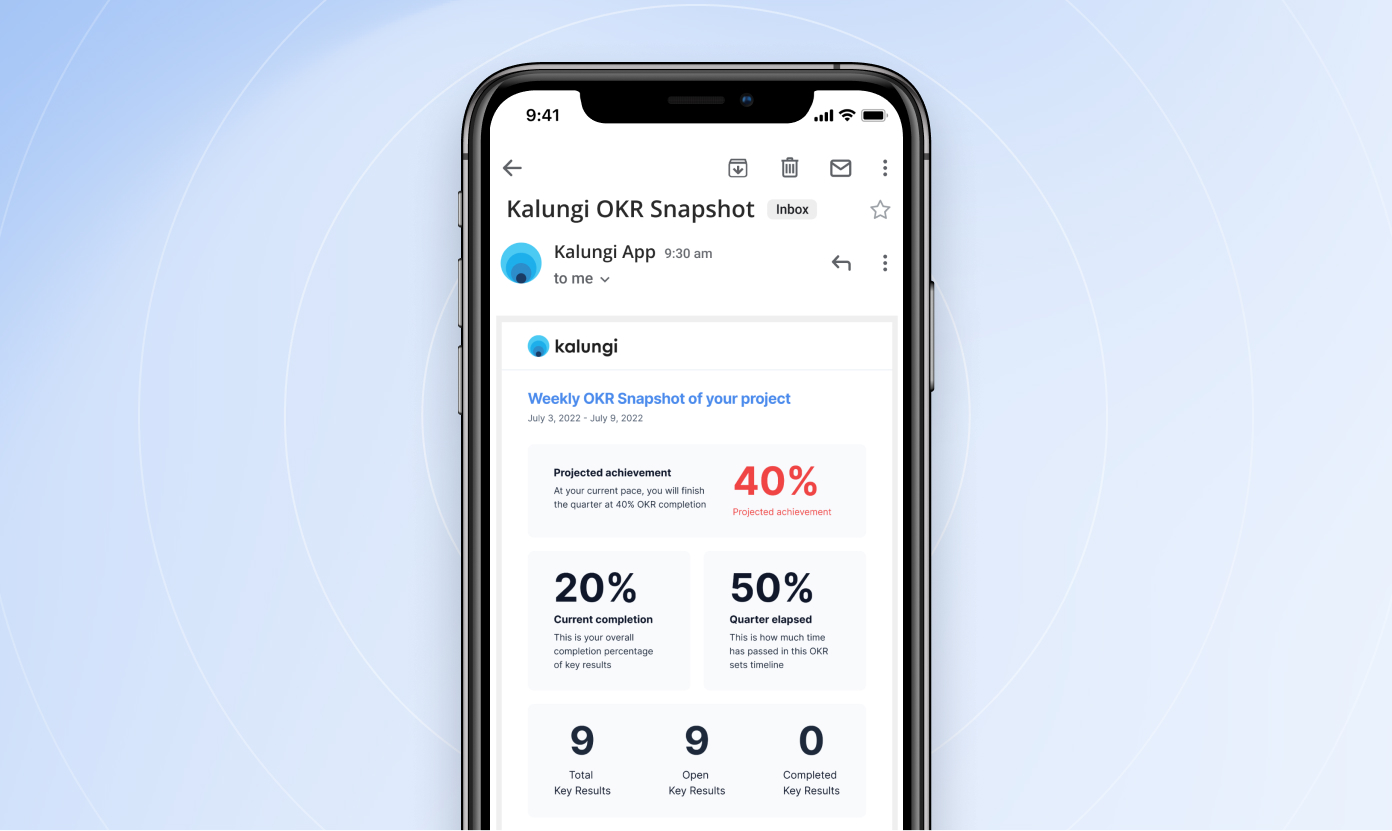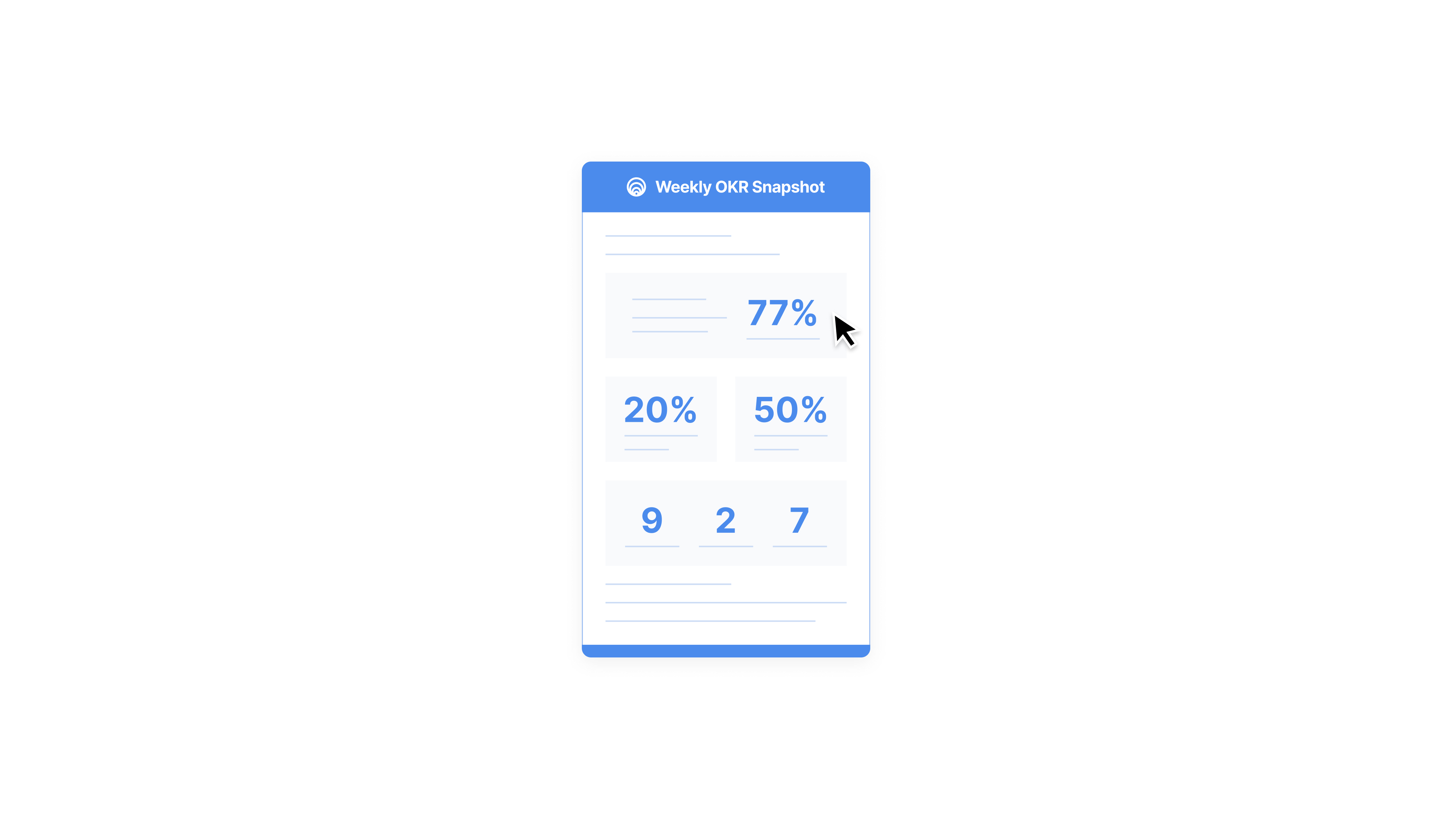Whether you’ve been able to make substantial progress that week or are feeling disappointed in what you’ve been able to achieve, promoting visibility into where you stand against your quarterly goals with an OKR report is essential. Beyond keeping your team accountable to their goals, OKRs (objectives and key results) allow them to quickly and easily present their highest priorities for the quarter.
With the speed SaaS companies need to operate at, OKRs are an essential tool for keeping yourself and your team focused on long-term goals and projects and preventing distraction as new tasks and projects come up over the quarter. Reporting regularly on them makes sure that they stay prioritized and are given the attention they require.
Is frequent OKR reporting worth the time?
Whether it takes the form of a regular meeting, looking through all of your team’s OKRs, prepared slides, or any other format, it can be frustrating to spend an hour or more each week reflecting on goal. However, these OKR report meetings can give your team a window into areas where things are not working and where they can support and reprioritize to ensure you are progressing toward your most important goals.
Checking in and regularly reporting on OKRs also makes sure that these OKRs are staying top-of-mind. As the quarter progresses, new priorities and tasks often arise that push OKRs off your team’s tick list. If you’re making sure that you are taking time each week, however, to look over your OKRs, you’ll have a constant reminder of what should be your main focus.
So, how can you be sure that you’re making the most efficient use of the time you are spending to report on your goals? Here we’ll look at some of the common approaches to OKR reporting, where they succeed and fall short, and how you can find the best approach for you.
To sync or not to sync
Perhaps the most common way of checking in and reporting on OKRs is with a meeting. Whether looking at team performance, sharing progress with a manager in a 1:1, or taking time in a group setting to review multiple people’s OKRs, these syncs allow for real-time Q&A and discussion on what’s going well and what’s not. There is some benefit to meeting on OKRs in this way, but this can be easily outweighed when these meetings come too frequently.
If you often run under time in these meetings or without any new questions or comments to share, try reducing these syncs to monthly or semi-quarterly. Just because there is value in sharing your OKRs frequently does not necessarily mean that there will be a lot of updates to share or requests from your team each week. In these cases, their time and yours should not then be wasted with weekly syncs.
Focus your focus
The best way to reduce the time spent on and increase the value provided by your OKR reports is to consciously focus on the most important pieces of your OKRs. If little has changed in your progress against some of your goals since your last update, there’s no need to dwell on the current status of those key results. Instead, dedicate time to highlighting those key results that need your immediate attention.
A strong report will answer these core questions:
- What have I done?
- Where do I stand?
- What’s next?
- Where do I need help?
If you find yourself speaking at length on topics that aren’t relevant to one of these core questions, it’s likely that you need to refocus your reporting and hone in on what’s important: your bottom-line goals and KPIs (ie. your OKRs) and what direct steps you are taking or need to take to achieve them.
Get it on tape
Instead of setting aside a piece of your’s and others’ workday each week for a meeting, consider summarizing your week’s OKR report in a short video. Using a platform like Loom, you can capture your explanation of where your OKRs stand, combined with reports, numbers, and any other visual aids. This way, others can then view them at any time without having to block off their calendars for a meeting.
After sending off your recording, pass along whatever slides or notes you referenced in your video to allow others to leave comments and ask questions.
While this option provides more schedule flexibility, it does not necessarily save the person reporting on these OKRs very much time. They’ll still need to prepare and present, potentially with multiple takes, what they’ve been working on and achieving.
Dave Gerhardt discusses the benefits and best practices of this reporting style in his episode on “Internal Marketing & What the CEO Really Wants from the Marketing Team” on the Exit Five podcast. Listen to the full episode here.
Automate it
One option to speed up your weekly OKR reporting is to automate large portions of it with an OKR management tool such as Leapsome, Gtmhub, Weekdone, or Kalungi’s own OKR management tool. Whether it’s in the form of customizable dashboards or automatically generated summaries, these services can make sharing progress on your goals a much faster process.

Weekly snapshot email from the Kalungi App’s OKR tool
It’s important to note that while these automated reports can be a great tool, they are not a complete replacement for meetings or recorded updates. Having a report to point to which displays how you’ve progressed and which goals you are behind on is valuable and can reduce the need for frequent in-person meetings. However, having time to discuss and explain how you’re working on these goals, even if only on a monthly basis, is still essential.
Make your priorities a priority
Though at times they may feel like a nuisance, providing your team and leadership with frequent updates on your progress on your most important goals is the best way to make sure they remain a priority. Not only are you reminding yourself of where your focus should be, but you’re letting others know where your time needs to be spent and when and how you could use their support.
